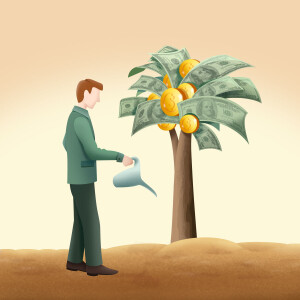Episodes

Monday Aug 21, 2023
Monday Aug 21, 2023
Chapter 1:The Black Swan Main Character
"The Black Swan" does not have a traditional narrative with a main character. Instead, it is a non-fiction book written by Nassim Nicholas Taleb that explores the concept of highly improbable and unpredictable events, known as "black swan" events.
In the book, Taleb discusses the impact of these rare and unexpected events on various aspects of life, such as finance, history, science, and personal decision-making. He argues that black swan events have a profound influence on our world, despite being difficult to predict or anticipate.
While "The Black Swan" doesn't follow a specific main character, Taleb's insights and analysis serve as the driving force behind the book. His unique perspective challenges conventional wisdom and encourages readers to think critically about uncertainty, randomness, and the limitations of our knowledge in shaping our understanding of the world.
It's important to note that the term "black swan" itself is derived from an ancient saying that presumed all swans were white until the discovery of black swans in Australia. Taleb uses this metaphor to illustrate the idea that seemingly impossible events can have significant consequences and reshape our understanding of reality.
Overall, "The Black Swan" offers readers a thought-provoking exploration of unpredictable events and their implications, providing valuable insights into the nature of uncertainty and the limitations of our ability to forecast the future.
Chapter 2:What does The Black Swan mean
In the context of Nassim Nicholas Taleb's book "The Black Swan," the term "black swan" refers to highly improbable and unpredictable events that have a significant impact. These events are characterized by their rarity, extreme impact, and retrospective predictability.
Taleb uses the metaphor of a black swan to illustrate that, just like people in Europe believed all swans were white until black swans were discovered in Australia, we often assume that certain events are impossible or highly unlikely until they actually occur.
"The Black Swan" challenges the traditional notion that the future can be predicted based on past experiences and data. Taleb argues that many important events in history, science, finance, and other domains are black swan events—events that neither experts nor statistical models anticipated due to their extreme rarity and the limitations of our knowledge.
The concept of the black swan emphasizes the need for humility, skepticism, and a recognition of uncertainty in our thinking. It encourages us to consider low-probability, high-impact events and their potential consequences when making decisions and assessing risks.
Overall, "The Black Swan" highlights how these unforeseen events can have profound implications and why it is essential to account for them in our understanding of the world, rather than relying solely on traditional models and predictions.
Chapter 3: The Black Swan Quotes
"Black Swans being unpredictable, we need to adjust to their existence (rather than naively try to predict them)."
"What we call here a Black Swan (and capitalize it) is an event with the following three attributes: It is an outlier, as it lies outside the realm of regular expectations because nothing in the past can convincingly point to its possibility."
"We humans are the victims of an asymmetry in the perception of random events. We attribute our successes to our skills, and our failures to external events outside our control, namely to randomness."
"People focus on noise. They don't realize that noise is less harmful than the absence of signals."
"The inability to predict outliers implies the inability to predict the course of history."
"Understanding the Black Swan logic makes us concentrate on the rare event, the very improbable one."
"It is easier to macrobullsht than to microbullsht."
"I want to live happily in a world I don’t understand."
"True knowledge is when one knows the limitations of one's knowledge."
"You are rich if and only if money you refuse tastes better than money you accept."

Monday Aug 21, 2023
Monday Aug 21, 2023
Chapter 1:What is The Five Dysfunctions of a Team
"The Five Dysfunctions of a Team" is a business book written by Patrick Lencioni. It explores the common challenges and dysfunctions that can hinder the effectiveness and success of a team within an organization.
The book takes the form of a leadership fable, which follows the story of a fictional executive team. Through this narrative, Lencioni presents the five main dysfunctions that teams often face and offers insights on how to overcome them.
The five dysfunctions are:
Absence of Trust: Without trust, team members hesitate to be vulnerable or transparent with one another. This lack of trust leads to an unwillingness to collaborate and share ideas openly.
Fear of Conflict: When team members are afraid of conflict, they tend to avoid healthy debates, resulting in a lack of innovation and poor decision-making. Open and constructive conflict is essential for high-performing teams.
Lack of Commitment: If team members do not fully buy into decisions, it becomes challenging to implement and execute plans effectively. A lack of commitment leads to ambiguity and indecisiveness.
Avoidance of Accountability: When individuals avoid holding themselves and others accountable, it fosters a culture of low performance and mediocrity. Embracing personal responsibility is crucial for creating a culture of excellence.
Inattention to Results: When team members prioritize their individual goals over collective objectives, it hampers overall team success. Focusing on achieving shared results is critical for building a high-performing team.
Chapter 2:The Five Dysfunctions of a Team author
The author of "The Five Dysfunctions of a Team" is Patrick Lencioni. Lencioni is a highly respected speaker, consultant, and writer specializing in leadership and organizational health. With a background in management consulting, he has worked with numerous organizations to improve their teamwork and overall effectiveness.
Lencioni's approach to writing is unique, as he often presents his ideas through fictional stories or fables that illustrate key concepts and principles. This storytelling technique allows readers to engage with the material on a deeper level and makes complex topics more relatable and understandable.
"The Five Dysfunctions of a Team" is one of Lencioni's most popular and influential works. Known for his extensive research and practical insights, Lencioni explores the common dysfunctions that hinder team performance and provides actionable strategies to address them.
As a sought-after speaker and consultant, Patrick Lencioni continues to share his expertise on leadership, teamwork, and organizational health, helping individuals and organizations build stronger teams and achieve greater success. His work has had a profound impact on countless leaders and organizations worldwide.
Chapter 3:Sparknotes The Five Dysfunctions of a Team
"The Five Dysfunctions of a Team" by Patrick Lencioni is a leadership fable that explores the common challenges and dysfunctions that hinder effective teamwork within organizations. The book presents a fictional story of an executive team and uses this narrative to illustrate the five main dysfunctions that teams often face.
These dysfunctions are the absence of trust, fear of conflict, lack of commitment, avoidance of accountability, and inattention to results. Through the story, Lencioni shows how these dysfunctions can arise and impact team dynamics and performance.
Lencioni then offers insights and practical strategies for leaders and team members to overcome these dysfunctions and build strong, cohesive teams. The book emphasizes the importance of building trust, embracing healthy conflict, fostering commitment, promoting accountability, and focusing on collective results.
Overall, "The Five Dysfunctions of a Team" provides valuable lessons and actionable guidance for improving teamwork and driving organizational success.

Monday Aug 21, 2023
Monday Aug 21, 2023
Chapter 1:The Meaning of The Power of Habit
"The Power of Habit" by Charles Duhigg explores the underlying mechanisms and significance of habits in our lives. The book delves into why we develop habits, how they are formed, and most importantly, how we can harness the power of habit to transform our behavior and achieve personal and professional success.
Duhigg investigates the science behind habit formation, drawing upon research from various fields such as psychology, neuroscience, and sociology. He explains the habit loop, which consists of a cue, routine, and reward, and reveals how understanding this loop can help us identify and modify our habits.
The book emphasizes that habits play a crucial role in shaping our daily actions, influencing everything from individual behavior to organizational cultures. By recognizing the patterns and triggers that drive our habits, we can gain control over them and make intentional changes.
"The Power of Habit" also explores the impact of habits on society, examining how organizations, advertising, and social movements use the science of habits to shape behaviors on a larger scale. It highlights the potential for individuals and groups to leverage this knowledge to create positive change in their lives and communities.
Overall, "The Power of Habit" provides insights into the intricate nature of habits and their influence on our lives. Through real-life examples and engaging storytelling, the book offers practical strategies and techniques for breaking bad habits, establishing new ones, and ultimately transforming ourselves for the better.
Chapter 2:How Does The Power of Habit End
"The Power of Habit" by Charles Duhigg concludes by emphasizing the potential for personal transformation through the understanding and manipulation of habits. Here is a brief summary of how the book ends:
The Power of Awareness: Duhigg emphasizes the importance of self-awareness in recognizing our habits and understanding the cues, routines, and rewards that drive them. By becoming more conscious of our behavior patterns, we can gain control over our habits and make intentional changes.
Keystone Habits and Ripple Effects: The book discusses the concept of keystone habits, which are small changes or habits that have the power to create a domino effect of positive transformations in various areas of our lives. By focusing on changing key habits, we can experience far-reaching impacts on our overall well-being and success.
Transforming Organizations: Duhigg explores how habits can shape organizational cultures and explains how leaders can use this knowledge to create positive change within their teams and companies. He provides examples of successful businesses that have embraced habit-based strategies to enhance productivity, innovation, and employee engagement.
Social Movements and Habit Change: The book also highlights the role of habits in driving social movements and societal shifts. Duhigg shares stories of individuals and communities who have harnessed the power of habits to bring about significant social and political change, showing that habits can influence collective behaviors on a larger scale.
In the final chapters, Duhigg encourages readers to apply the principles and insights from the book to their own lives. He challenges readers to identify their habits, experiment with habit changes, and embrace the potential for personal growth and transformation that comes with understanding the power of habit.
Chapter 3:Quotes for The Power of Habit
"Change might not be fast and it isn't always easy. But with time and effort, almost any habit can be reshaped."
"Habits, scientists say, emerge because the brain is constantly looking for ways to save effort."
"This is the real power of habit: the insight that your habits are what you choose them to be."
"Once you understand that habits can change, you have the freedom and the responsibility to remake them."
"Champions don’t do extraordinary things. They do ordinary things, but they do them without thinking, too fast for the other team to react. They follow the habits they’ve learned."
"The Golden Rule of Habit Change: You can't extinguish a bad habit, you can only change it."
"Small wins are a steady application of a small advantage."
"Willpower isn't just a skill. It's a muscle, like the muscles in your arms or legs, and it gets tired as it works harder, so there's less power left over for other things."
"The key to exercising regularly, losing

Monday Aug 21, 2023
Monday Aug 21, 2023
Chapter 1:Intelligent Investor Audiobook
The audiobook version of "The Intelligent Investor" by Benjamin Graham is available for those who prefer to listen to the book rather than reading it in print. The audiobook provides an accessible and convenient way to engage with the classic investment guide.
Narrated by a professional voice actor, the audiobook captures the essence of Graham's timeless wisdom and investment strategies. Listeners can absorb the concepts and principles outlined in the book through the engaging narration, making it easier to grasp complex financial concepts.
By choosing the audiobook format, readers have the flexibility to listen while commuting, exercising, or engaging in other activities. This allows for a more immersive and productive use of time while gaining valuable insights into intelligent investing.
"The Intelligent Investor" audiobook serves as a comprehensive guide to value investing, emphasizing long-term thinking, risk management, and understanding market fluctuations. It provides practical advice on analyzing stocks, building a diversified portfolio, and maintaining a disciplined approach to investing.
Whether you prefer reading the print version or opt for the audiobook, both formats offer opportunities to learn from Benjamin Graham's investment philosophy and apply his principles to achieve financial security and success in the stock market.
Chapter 2:The Intelligent Investor Review
"The Intelligent Investor" by Benjamin Graham is widely regarded as a classic in the field of investment literature. Here is an overview of some common themes and reviews associated with the book:
Value Investing: One of the key ideas presented in the book is the concept of value investing. Graham advocates for investors to focus on the intrinsic value of a stock rather than short-term market fluctuations. He emphasizes the importance of thorough analysis, patience, and buying stocks at a price below their intrinsic value.
Margin of Safety: Another significant principle highlighted in the book is the idea of a margin of safety. Graham advises investors to only purchase stocks when they are trading at a significant discount to their calculated intrinsic value. This approach aims to protect against downside risk and potential losses.
Long-Term Perspective: Graham emphasizes the importance of having a long-term perspective in investing. He encourages investors to resist the temptation of quick gains and speculations, instead advocating for a patient and disciplined approach that focuses on long-term financial security.
Practical Advice: "The Intelligent Investor" not only presents theoretical concepts but also offers practical advice. Graham provides guidelines on analyzing financial statements, evaluating company performance, and constructing a well-diversified portfolio. These insights are often praised for their clarity and actionable nature.
Reviews of the book generally reflect its status as a must-read for investors. Many readers appreciate Graham's ability to distill complex investment concepts into understandable language, making it accessible for beginner and experienced investors alike. Additionally, the timeless principles and strategies presented in the book continue to resonate with investors, even decades after its initial publication.
That said, it is important to recognize that investing is a dynamic field, and some readers may find certain aspects of the book to be outdated or overly conservative. It's recommended to read "The Intelligent Investor" in conjunction with more contemporary resources to gain a comprehensive understanding of modern investment practices.
Overall, "The Intelligent Investor" is considered a seminal work that offers valuable insights into the world of investing, providing a foundation for prudent investment strategies and long-term financial success.
Chapter 3:When Was Intelligent Investor Written
"The Intelligent Investor" was originally written by Benjamin Graham and first published in 1949. Over the years, it has been considered a seminal work on value investing and has had a significant impact on the field of investment literature. Despite being written several decades ago, the principles and concepts presented in the book continue to be highly relevant and influential in modern investment practices. Graham's insights have stood the test of time, making "The Intelligent Investor" a timeless classic that remains widely read and respected by investors and financial professionals around the world.

Monday Aug 21, 2023
Monday Aug 21, 2023
Chapter 1:What is the book Lean Startup about
"The Lean Startup" by Eric Ries is a book that introduces the concept of lean startup methodology, which aims to help entrepreneurs and businesses develop products and services more efficiently and effectively.
The book focuses on the principles of continuous innovation, rapid iteration, and validated learning. It encourages entrepreneurs to adopt a scientific approach to entrepreneurship, treating their business ideas as hypotheses that need to be tested and validated through experimentation.
Ries emphasizes the importance of building a Minimum Viable Product (MVP) - a simplified version of a product or service that allows for early testing and feedback from customers. By gathering data and customer insights, entrepreneurs can make informed decisions and adapt their strategies accordingly.
"The Lean Startup" also discusses the concept of pivoting, which involves making strategic changes to a business model based on feedback and market conditions. Through constant iteration and learning, entrepreneurs can increase their chances of building successful and sustainable businesses.
Furthermore, the book explores the importance of creating a culture of innovation within organizations, fostering an environment where experimentation and learning are valued and encouraged.
Overall, "The Lean Startup" serves as a guide for entrepreneurs and businesses seeking to navigate the uncertainties of the market and build innovative products or services by adopting a lean and iterative approach.
Chapter 2:Why is Lean Startup a classic
Innovative Approach: The book introduced a fresh and revolutionary approach to entrepreneurship, challenging traditional notions of product development and business strategy. Ries's emphasis on experimentation, validated learning, and iterative development offered a new perspective on how startups can navigate the uncertainties of the market.
Practical Guidance: Ries provides practical guidance and actionable advice throughout the book. He offers specific tools and techniques that entrepreneurs can apply in their own ventures, such as building MVPs, conducting customer interviews, and implementing feedback loops. This practicality makes the book highly useful for aspiring entrepreneurs and business leaders.
Impact on Startup Culture: "The Lean Startup" had a significant impact on startup culture, influencing how entrepreneurs approach product development, customer validation, and the measurement of success. The book's concepts and principles have been widely adopted by startups and established companies alike, contributing to the growth of the lean startup movement and shaping entrepreneurial practices globally.
Enduring Relevance: Despite being published over a decade ago, "The Lean Startup" remains relevant today. Its emphasis on agility, adaptability, and continuous improvement aligns with the fast-paced and rapidly changing business landscape. The book's core principles continue to resonate with aspiring entrepreneurs, providing timeless insights into building successful businesses.
Influence on Entrepreneurial Literature: "The Lean Startup" has had a profound influence on subsequent books, articles, and discussions in the field of entrepreneurship. It sparked further exploration and refinement of lean startup methodologies, leading to a rich body of literature and a broader understanding of how startups can navigate uncertainty and increase their chances of success.
Chapter 3:Lean Startup Characters
"The Lean Startup" by Eric Ries is a non-fiction book that primarily focuses on concepts and methodologies for entrepreneurship and business. As such, it does not have any fictional characters or a narrative-driven story with specific individuals.
Instead, the book discusses real-life case studies, examples, and experiences from various entrepreneurs and businesses. These examples serve to illustrate the principles and concepts outlined in the book, showcasing how lean startup methodology has been applied successfully in different contexts.
While there aren't specific characters within "The Lean Startup," the book emphasizes the importance of understanding customer behavior, working with cross-functional teams, and fostering a culture of innovation within organizations. It encourages readers to adopt a scientific approach to entrepreneurship and build collaborative environments that drive experimentation and continuous improvement.
Therefore, rather than focusing on individual characters, "The Lean Startup" highlights the collective efforts, challenges, and successes of entrepreneurs and businesses as they apply the principles of lean startup methodology in their respective journeys.

Monday Aug 21, 2023
Monday Aug 21, 2023
Chapter 1:Grit Summary
"Grit: The Power of Passion and Perseverance" by Angela Duckworth explores the concept of grit and its role in achieving long-term success and personal fulfillment. Duckworth defines grit as the combination of passion and perseverance towards goals despite challenges and setbacks.
Throughout the book, Duckworth presents evidence and insights from her research on the importance of grit. She argues that talent alone is not enough to ensure success; grit plays a vital role in pushing through difficulties and achieving one's full potential.
Duckworth shares stories of individuals from various fields who exemplify grit, including athletes, artists, educators, and entrepreneurs. By examining their experiences, she highlights the common traits and practices they possess, such as a growth mindset, deliberate practice, and resilience.
The book emphasizes the idea that grit can be developed and nurtured over time. Duckworth provides practical strategies for cultivating grit, including setting specific goals, maintaining passion, embracing failure as an opportunity for learning, and practicing perseverance.
Duckworth also addresses the importance of fostering grit in children and offers guidance for parents and educators on how to cultivate this quality in young individuals.
Overall, "Grit" challenges the notion that success is solely determined by innate talent and highlights the power of passion and perseverance in achieving long-term goals. It serves as a roadmap for developing grit and harnessing its potential to overcome challenges and achieve extraordinary results.
Chapter 2:Theme of Grit
The main theme of "Grit: The Power of Passion and Perseverance" by Angela Duckworth is the concept of grit itself. Grit is defined as a combination of passion and perseverance towards long-term goals. It is the ability to maintain effort and resilience in the face of obstacles, setbacks, and challenges.
Throughout the book, Duckworth explores various aspects related to the theme of grit:
Importance of Effort and Perseverance: The book emphasizes that talent alone is not enough for success and achievement. Grit plays a vital role in pushing through difficulties and staying committed to long-term goals.
Passion and Purpose: Duckworth stresses the significance of having a deep sense of purpose and following one's passion. Grit is strengthened when individuals are driven by their interests and intrinsic motivation.
Growth Mindset: Developing a growth mindset, which involves believing that abilities can be developed through efforts and learning, is crucial for cultivating grit. Embracing challenges, viewing mistakes as opportunities for growth, and persisting in the face of setbacks are important elements of a growth mindset.
Deliberate Practice: Duckworth discusses the concept of deliberate practice, which involves intentional and focused efforts to improve skills and abilities. Consistently practicing with clear goals and seeking feedback are key components of developing grit.
Resilience and Mental Toughness: Grit entails resilience and mental toughness, where individuals bounce back from failures, adapt to change, and remain determined despite adversity.
Chapter 3:Grit Audiobook
The audiobook version of "Grit: The Power of Passion and Perseverance" by Angela Duckworth is available for those who prefer to listen to the book. It offers an alternative way to engage with the content and absorb the valuable insights shared by the author.
The audiobook version of "Grit" is narrated by Angela Duckworth herself, allowing listeners to hear the author's voice as she discusses her research, shares anecdotes, and provides practical advice on cultivating grit in one's life. This can provide a more immersive and personal experience for those who enjoy hearing the author's perspective directly.
Listening to the audiobook allows individuals to learn about the concept of grit and its significance in achieving long-term success while engaging in other activities like commuting, exercising, or doing household tasks. It offers flexibility and convenience for those who prefer audio formats or have limited time for reading.
Whether readers choose the physical book or the audiobook version, both offer valuable insights into developing passion, perseverance, and resilience – qualities that can lead to exceptional achievements and personal growth.

Friday Aug 18, 2023
Friday Aug 18, 2023
Chapter 1:What is Agatha Christie about
Agatha Christie is not the title of a specific book but instead refers to the renowned British author herself. Agatha Christie wrote numerous books, each with its own unique plot, characters, and setting. Her books primarily fall into the mystery and detective fiction genres.
Agatha Christie's books typically revolve around intriguing mysteries that need to be solved. They often involve crimes like murders or disappearances and feature skilled detectives who use their intelligence, observation skills, and deductive reasoning to unravel the truth. Some of her most famous characters include Hercule Poirot, Miss Marple, and Tommy and Tuppence.
The plots of Agatha Christie's books are known for their intricacy, suspense, and unexpected twists. She was skilled at creating puzzles that kept readers guessing until the very end. Her writing style was characterized by meticulous attention to detail and clever storytelling techniques.
While there isn't a specific book titled "Agatha Christie," some of her notable works include "Murder on the Orient Express," "And Then There Were None," "The Murder of Roger Ackroyd," and "Death on the Nile." These books showcase her talent for crafting compelling mysteries that have captivated readers for generations.
In summary, Agatha Christie's books offer captivating and suspenseful tales of mystery and crime. Each book presents a unique story filled with intrigue, surprises, and fascinating characters as readers embark on a journey to uncover the truth behind the mysteries.
Chapter 2:Who is Agatha Christie
Agatha Christie was a renowned British author born on September 15, 1890, in Torquay, Devon, England. She is widely regarded as one of the greatest crime writers in history and is known for her detective novels and plays.
Christie's career spanned several decades, during which she wrote numerous novels, short stories, and plays. Her works have been translated into multiple languages and have sold millions of copies worldwide. She is often referred to as the "Queen of Crime" or the "Queen of Mystery."
Agatha Christie created iconic characters such as Hercule Poirot, a Belgian detective with a brilliant mind and distinctive mustache, and Miss Marple, an elderly spinster with a sharp intellect and keen observational skills. These characters appeared in various novels and became beloved figures in the world of detective fiction.
Christie's writing style is characterized by intricate plots, unexpected twists, and clever solutions to mysterious crimes. She had a unique ability to keep readers guessing until the very end, making her novels highly engaging and suspenseful.
Apart from her detective fiction, Agatha Christie also wrote several plays, including "The Mousetrap," which became the longest-running play in London's West End.
Agatha Christie's contributions to the crime genre and her impact on popular culture cannot be overstated. Her works continue to be celebrated, adapted into films, TV shows, and stage productions, and are enjoyed by readers of all ages. Agatha Christie's legacy as a master storyteller and the enduring popularity of her works have solidified her place in literary history.
Chapter 3:Agatha Christie Books
Agatha Christie wrote an extensive collection of books throughout her career, including numerous novels, short story collections, and plays. Here are some notable works by Agatha Christie:
"Murder on the Orient Express" (1934)
"And Then There Were None" (1939)
"The Murder of Roger Ackroyd" (1926)
"Death on the Nile" (1937)
"The A.B.C. Murders" (1936)
"The Mousetrap" (1952) - This is Christie's most famous play, known for its long-running success in London's West End.
"Curtain: Poirot's Last Case" (1975) - This novel marks the final appearance of Hercule Poirot, one of Christie's iconic detective characters.
"Murder at the Vicarage" (1930) - The first novel featuring Miss Marple, another beloved detective character created by Christie.
"Five Little Pigs" (1942)
"The Body in the Library" (1942)

Friday Aug 18, 2023
Friday Aug 18, 2023
Chapter 1:What is the Frankenstein about
"Frankenstein" is a novel written by Mary Shelley and published in 1818. It tells the story of Victor Frankenstein, a young scientist who becomes obsessed with creating life. In his pursuit of knowledge and power, Victor successfully brings a creature to life using unconventional scientific methods. However, horrified by his own creation's monstrous appearance, Victor abandons it.
The creature, left alone and rejected by its creator and society, struggles to find acceptance and understanding. As it experiences rejection and cruelty from humans, the creature turns vengeful and seeks revenge on Victor, ultimately resulting in a tragic series of events that challenges the boundaries between science, morality, and the consequences of playing god.
The novel explores themes of scientific ambition, the human desire for power and knowledge, the responsibility of creators towards their creations, alienation, and the complexities of humanity. It raises profound questions about identity, ethics, and the moral implications of tampering with nature.
Through the contrasting perspectives of Victor Frankenstein and his creation, Mary Shelley offers a profound commentary on the human condition and the potential dangers of unchecked scientific advancements. "Frankenstein" has become a classic literary work that continues to captivate readers and spark discussions on the ethical implications of scientific progress and the nature of humanity itself.
Chapter 2:Frankenstein Ending
The ending of "Frankenstein" by Mary Shelley is poignant and tragic. After a series of devastating events, the novel concludes with Victor Frankenstein in pursuit of his creation, determined to bring an end to its existence. The chase leads them to the Arctic, where after a final confrontation, both Victor and the creature meet their respective fates.
In the end, Victor succumbs to exhaustion and dies aboard a ship in the frigid wilderness. Before his death, he expresses regret for his obsession with creating life and acknowledges the consequences of his actions. The creature, grieving the loss of its creator and overwhelmed by loneliness, appears at Victor's funeral pyre. It laments the pain and suffering it has experienced as a result of its isolation from society.
The creature's monologue at the end reflects its remorse and desire for redemption. It vows to end its own life, believing that there is no place for it in the world. The novel closes with the creature disappearing into the darkness of the Arctic, leaving the readers to contemplate the implications of Victor's ambitious quest and the repercussions of rejecting and mistreating the other.
Shelley's ending highlights the tragic consequences of Victor's ambition and the destructive cycle of rejection and vengeance. It raises questions about responsibility, empathy, and the consequences of neglecting one's creations. The conclusion leaves the readers with a sense of sorrow and reflection on the complexities of human nature and the moral dilemmas presented throughout the novel.
Chapter 3:Books like Frankenstein
"Dracula" by Bram Stoker: This classic novel tells the story of Count Dracula, a vampire who seeks to spread his curse in Victorian England. It delves into themes of evil, desire, and the struggle between good and evil.
"The Picture of Dorian Gray" by Oscar Wilde: This novel explores the consequences of vanity, immortality, and the pursuit of pleasure. It follows the life of Dorian Gray, whose portrait ages and reflects his sins while he remains eternally young.
"The Strange Case of Dr. Jekyll and Mr. Hyde" by Robert Louis Stevenson: This novella delves into the duality of human nature. It tells the story of Dr. Jekyll, who creates a potion that transforms him into the sinister Mr. Hyde, revealing the dark side of his personality.
"We Have Always Lived in the Castle" by Shirley Jackson: This haunting story follows two sisters, Constance and Merricat, living in isolation after a tragedy. It explores themes of guilt, family secrets, and the boundaries of societal norms.
"Wuthering Heights" by Emily Brontë: This gothic romance novel explores love, revenge, and the destructive power of obsession. The story revolves around the passionate relationship between Heathcliff and Catherine Earnshaw, set against the backdrop of the desolate moors.
"The Monk" by Matthew Lewis: This influential gothic novel focuses on the downfall of Ambrosio, a virtuous monk corrupted by lust and temptation. It contains elements of supernatural horror, religious critique, and moral corruption.
"Rebecca" by Daphne du Maurier: This atmospheric novel tells the story of a young woman who becomes the second wife of Maxim de Winter. As she settles into his grand estate, she unravels the secrets and mysteries surrounding his deceased first wife, Rebecca.

Friday Aug 18, 2023
Friday Aug 18, 2023
Chapter 1:Where does the Good To Great take place
"Good to Great: Why Some Companies Make the Leap... and Others Don't" by Jim Collins does not take place in a specific physical location. The book is a business management study that examines successful companies and their transformation from being good to becoming great. It focuses on analyzing data and case studies of various businesses across different industries to identify the factors and strategies that contributed to their long-term success.
While the book discusses real-life examples of companies such as Walgreens, Kimberly-Clark, and Wells Fargo, it does not center around a particular location or setting. Instead, it explores the principles and practices that can lead organizations to achieve greatness, regardless of their geographical location.
Chapter 2:Good To Great Synopsis
"Good to Great: Why Some Companies Make the Leap... and Others Don't" by Jim Collins is a highly influential business book that examines what sets great companies apart from their competitors. Collins and his research team analyzed a vast amount of data and conducted in-depth case studies to identify common patterns and principles that enable companies to achieve sustained success.
The book presents key findings based on a comparison of "good" companies that failed to become great and companies that achieved long-term greatness. Collins explores various concepts, including leadership, organizational culture, strategic choices, and disciplined execution.
One of the main ideas discussed in "Good to Great" is the importance of having a Level 5 leader – someone who possesses a rare combination of humility and fierce resolve, placing the interests of the company above personal ambition. Collins also emphasizes the significance of getting the right people on board, ensuring that the company has a strong foundation of talented individuals.
Another crucial aspect highlighted in the book is the concept of the Hedgehog Concept, which involves finding the intersection of what a company can be the best in the world at, what it is deeply passionate about, and what drives its economic engine. This concept helps guide a company's strategic decisions and focus its efforts on areas where it can excel.
Furthermore, "Good to Great" emphasizes the importance of disciplined action and an unwavering commitment to excellence. It advocates for a relentless pursuit of improvement, maintaining a culture of discipline, and embracing technological changes as accelerators rather than drivers of success.
Overall, the book provides valuable insights and actionable strategies for leaders and organizations aspiring to transition from being good to achieving lasting greatness. It combines rigorous research with compelling storytelling to offer timeless lessons on building successful businesses.
Chapter 3:The Good To Great Meaning
The meaning behind "Good to Great: Why Some Companies Make the Leap... and Others Don't" by Jim Collins lies in uncovering the factors and strategies that separate truly great companies from their merely good counterparts. The book delves into the characteristics, practices, and leadership qualities that enable certain organizations to achieve exceptional long-term success.
The central message of the book is that greatness is not a result of sudden breakthroughs or overnight transformations, but rather a product of sustained efforts and disciplined execution over time. It emphasizes that greatness is attainable for any company willing to adopt the right mindset, make strategic choices, and cultivate a culture of excellence.
Collins argues that great companies are driven by Level 5 leaders who possess a unique blend of humility, determination, and commitment to the organization's success. These leaders prioritize the collective interests of the company above personal recognition or fame.
Furthermore, the concept of the Hedgehog Concept serves as a guiding principle for companies striving for greatness. This concept involves aligning the company's core capabilities, passions, and economic drivers to create a focused strategy that sets it apart from competitors.
Discipline is another essential element highlighted in the book. Great companies demonstrate unwavering discipline in their actions, decisions, and operations. They set clear goals, stick to their core values, and maintain a consistent focus on what they can do exceptionally well.
Ultimately, the meaning of "Good to Great" lies in showcasing that greatness is within reach for organizations willing to embrace disciplined action, cultivate strong leadership, and make strategic choices aligned with their unique strengths. It encourages businesses to strive for excellence and provides insights and principles to guide them on the path to sustained success.

Friday Aug 18, 2023
Friday Aug 18, 2023
Chapter 1:Never Splitting the Difference Genre
"Never Split the Difference" is a captivating non-fiction book that falls within the genre of business and communication. Written by former FBI hostage negotiator Chris Voss, it provides valuable insights and practical strategies for effective negotiation.
The book draws on Voss's extensive experience in high-stakes negotiations, offering readers a unique perspective that blends the worlds of law enforcement and business. While it primarily caters to professionals involved in negotiation scenarios, its teachings are applicable to various aspects of life where persuasion and influence play vital roles.
With a gripping narrative and real-life anecdotes, "Never Split the Difference" explores the art of negotiation through the lens of human psychology and emotions. It challenges conventional wisdom and introduces innovative techniques for achieving successful outcomes, even in challenging situations.
By delving into topics such as active listening, empathetic communication, and strategic decision-making, the book equips readers with the tools to navigate complex negotiations effectively. It emphasizes the importance of understanding and influencing the underlying motivations and desires of the parties involved to reach mutually beneficial agreements.
While "Never Split the Difference" specifically focuses on negotiation, its principles extend beyond business settings. The book is relevant to anyone seeking to enhance their communication skills, build better relationships, and navigate difficult conversations with confidence and success.
In summary, "Never Split the Difference" belongs to the genre of business and communication, delivering a compelling and enlightening exploration of negotiation strategies that can have a profound impact on professional and personal interactions.
Chapter 2:The Never Splitting the Difference Review
"Never Split the Difference" has generally received positive reviews from readers and critics alike. Many praise the book for its practicality, real-world examples, and engaging storytelling. Chris Voss's background as an FBI hostage negotiator lends credibility and adds to the book's appeal.
Reviewers often highlight the unique perspective that Voss brings to negotiation strategies, drawing from his experiences in high-stakes situations. The book offers valuable insights into human psychology, emotional intelligence, and effective communication techniques, which can be applied not only in business negotiations but also in various interpersonal interactions.
Readers appreciate the actionable advice and practical tips provided throughout the book. Voss's emphasis on active listening, empathy, and understanding the motivations of others resonates with many, leading to improved negotiation outcomes.
However, a few reviewers have pointed out that some techniques presented in the book may not be applicable in all situations or cultural contexts. It is important to adapt and tailor the strategies to specific circumstances and individual negotiating styles.
Overall, "Never Split the Difference" is widely regarded as a valuable resource for anyone looking to enhance their negotiation skills and achieve better outcomes in various aspects of life. It is praised for its practicality, engaging writing style, and the unique perspective it offers through Chris Voss's expertise as a former FBI negotiator.
Chapter 3:Characters in Never Splitting the Difference
"Never Split the Difference" by Chris Voss is a non-fiction book that primarily focuses on negotiation techniques and strategies. As such, it does not have a traditional cast of characters like a novel would. However, the book does feature various real-life examples, anecdotes, and case studies to illustrate the author's points and provide practical insights into negotiation scenarios.
While specific individuals may be mentioned in these examples, they are typically not recurring characters throughout the book. Instead, the emphasis is placed on the negotiation dynamics, challenges, and tactics employed in those particular situations.
It's important to note that "Never Split the Difference" draws from Chris Voss's experiences as an FBI hostage negotiator, so he shares his own personal encounters and the lessons learned from them. While the book may reference specific individuals involved in those negotiations, they are generally described in the context of the broader lessons being conveyed rather than as recurring characters.
Overall, the focus of "Never Split the Difference" is more on imparting negotiation strategies and techniques rather than developing distinct characters within a narrative structure.








